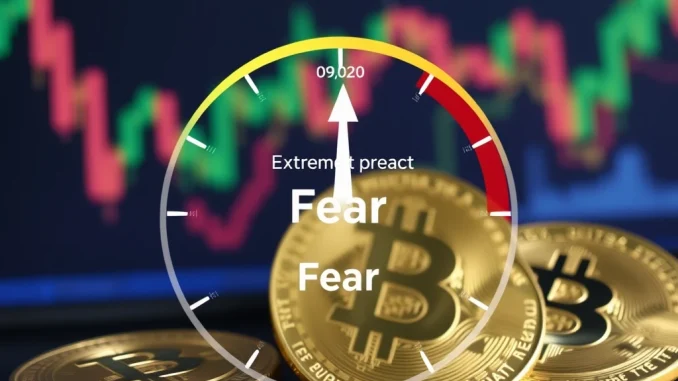
Navigating the volatile world of cryptocurrency requires more than just watching price charts. To truly understand market dynamics, savvy investors often turn to sentiment analysis. One crucial tool in this arsenal is the Crypto Fear & Greed Index. As of April 19th, this index, a product of Alternative.me, has dipped further into the ‘Fear’ zone, falling to 32. This one-point decrease from the previous day signals a continued weakening in overall market sentiment.
Decoding the Crypto Fear & Greed Index: What Does ‘Fear’ Really Mean?
The Crypto Fear & Greed Index isn’t just a random number; it’s a carefully calculated metric designed to gauge the emotional temperature of the cryptocurrency market. Ranging from 0 (Extreme Fear) to 100 (Extreme Greed), this index acts as a compass, helping investors understand whether the market is being driven by excessive fear or irrational exuberance. Currently hovering at 32, the index firmly resides in the ‘Fear’ zone. But what does this ‘Fear’ zone actually imply for you, the crypto enthusiast or investor?
A ‘Fear’ reading, like the current 32, suggests that investors are becoming increasingly anxious about potential market downturns. This anxiety can stem from various factors, including negative news cycles, regulatory uncertainties, or broader economic concerns. Historically, periods of extreme fear can sometimes present buying opportunities, as assets may be undervalued due to panic selling. Conversely, extreme greed can signal a market bubble, potentially preceding a correction.
What Factors Drive the Crypto Fear & Greed Index?
To provide a comprehensive view of market sentiment, the Crypto Fear & Greed Index considers a diverse range of data points, each weighted to reflect its influence on overall market psychology. These factors are:
- Volatility (25%): Measures the current volatility of Bitcoin and other cryptocurrencies against their 30-day and 90-day averages. Unusual increases in volatility often indicate fear.
- Market Momentum/Volume (25%): Compares the current market momentum and trading volume to the 30-day and 90-day averages. High buying volume indicates greed, while low volume may suggest fear.
- Social Media (15%): Analyzes sentiment across social media platforms, primarily Twitter, for relevant crypto hashtags. High positive engagement points to greed, while negative sentiment reflects fear.
- Surveys (15%): Conducts weekly crypto polls to gauge investor sentiment directly. This provides a more immediate snapshot of how traders and investors are feeling.
- Bitcoin Dominance (10%): Tracks Bitcoin’s dominance in the overall crypto market. Increased Bitcoin dominance can sometimes signal a ‘flight to safety’ during fearful periods.
- Google Trends (10%): Analyzes Google Trends data for Bitcoin-related search queries. Surges in searches like “Bitcoin crash” can indicate fear, while searches for “buy Bitcoin” might suggest greed.

Navigating the ‘Fear’ Zone: What Actions Should Crypto Investors Consider?
With the Crypto Fear & Greed Index persistently in the ‘Fear’ zone, what should crypto investors do? It’s crucial to remember that the index is just one tool, and not a crystal ball. However, it can provide valuable insights to inform your investment strategy. Here are some actionable insights:
- Exercise Caution, Not Panic: ‘Fear’ doesn’t necessarily mean a market crash is imminent. It simply suggests heightened anxiety. Use this as a signal to review your portfolio and risk management strategies, rather than making impulsive decisions.
- Identify Potential Buying Opportunities: Historically, periods of high fear have sometimes preceded market recoveries. Conduct thorough research and identify fundamentally strong projects that may be undervalued during this period. Dollar-cost averaging could be a prudent approach.
- Stay Informed, But Filter Noise: Pay attention to market news and analysis, but be wary of sensationalist headlines that can amplify fear. Focus on credible sources and fundamental analysis.
- Diversify Your Portfolio: A diversified portfolio can help mitigate risk during periods of market uncertainty. Don’t put all your eggs in one basket, especially when fear is prevalent.
- Long-Term Perspective is Key: Cryptocurrency markets are inherently volatile. If you have a long-term investment horizon, short-term ‘Fear’ readings might be less concerning. Focus on the long-term potential of your chosen assets.
The Role of Bitcoin Dominance in Market Sentiment
The Bitcoin dominance metric, a component of the Fear & Greed Index, deserves specific attention. When Bitcoin dominance increases, it often indicates that investors are moving funds from altcoins back into Bitcoin, perceived as a safer haven during market uncertainty. Conversely, decreasing Bitcoin dominance can suggest a higher risk appetite, with investors venturing into altcoins. Monitoring Bitcoin dominance alongside the overall index can provide a more nuanced understanding of the prevailing crypto market dynamics.
Understanding Market Volatility and Its Impact on Fear
Market volatility is another significant driver of the Crypto Fear & Greed Index. High volatility, characterized by rapid and unpredictable price swings, naturally fuels fear and uncertainty. When prices fluctuate wildly, investors become more risk-averse, contributing to a ‘Fear’ reading on the index. Conversely, periods of low volatility and stable price movements can lead to complacency and potentially, increased greed. Therefore, keeping an eye on volatility indicators alongside the Fear & Greed Index can offer a more complete picture of market sentiment.
Conclusion: Harnessing the Power of Sentiment Analysis
The Crypto Fear & Greed Index serves as a valuable tool for understanding the emotional undercurrents of the cryptocurrency market. While the current reading of 32 in the ‘Fear’ zone suggests caution, it’s essential to interpret this information within a broader context. By understanding the factors that drive the index, and by combining sentiment analysis with fundamental research and risk management, crypto investors can navigate market fluctuations more effectively and make informed decisions. Don’t let fear paralyze you; use it as a signal to be prudent, informed, and strategic in your crypto journey.



